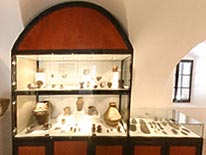|
Head: Lana Okroša Rožić, curator
| The
permanent display |
 |
 |
From its very beginnings the Museum strived to acquire
archaeological material from the sites in the Križevci
area. The first items were gathered by purchasing V. Dukić’s
collection. Dukić was a teacher and an amateur archaeologist
who collected archaeological artefacts in the Apatovac
and Dubovec area, where he worked. The first important
archaeological excavations were closely related to professor
S. Dimitrijević, Ph.D., who was researching the late Neolithic
site of Brezovljani in 1973.
Z. Marković was hired as the first curator-archaeologist
in the Križevci Municipal Museum in 1977 and in the very
same year he took part in the excavations of a site of
Vučedol culture in Apatovac.
The arrival of the archaeologist Z. Homen in 1978 intensified
the research: in the late 1970s and 1980s he supervised
the excavations of Aeneolithic sites of Lasinja culture
in Beketinec, Bukovje and Grabovac, those of the late
Bronze Age site of Križevci-Ciglana and the excavations
of a medieval cemetery of Bijelo Brdo culture at the site
of Popovec Kalnički. In the late 1990s he conducted protective
excavations of a site in Glogovnica, where an apse of
a 13th-century Romanesque church was discovered, together
with remnants of the citadel complex of the Glogovnica
collegiate church, torn down in the 16th century.
The Museum has a tradition of cooperation with similar
institution when it comes to its field research. In 1987,
for example, test excavations of a medieval cemetery of
Bijelo Brdo culture in Obrežje Kalničko were carried out
in cooperation with the Archaeological Institute. Between
1988 and 1990 the late Bronze Age site of Kalnik-Igrišće
was researched in cooperation with the Department of Archaeology
of the Faculty of Philosophy in Zagreb.
Lana Okroša Rožić joined the Museum team in 1999 as a
curator-archaeologist and oversaw systematic research
of the Neolithic site of Brezovljani. In 2003 she supervised
protective excavations of a medieval site in Kamešnica,
where remnants of a 13th-century Romanesque church were
discovered.
The Archaeological Collection consists of material dating
from different periods - ranging from the New Stone Age
(Neolithic) to the late Middle Ages - acquired through
archaeological excavations or as pure chance finds.
The Museum is especially proud of its ceramic and lithic
items dating from the prehistoric period. Neolithic items
belong mostly to the Brezovljani type of Sopot culture
and the Aeneolithic period is represented through the
finds of Lasinja and Vučedol culture. Ceramic finds of
the late Bronze Age are complemented with various examples
of bronze jewellery and tools. Stone moulds used for casting
bronze objects are of special interest. Exhibits belonging
to the late medieval period are also numerous and include
ceramic vessels, oven bricks, infantrymen’s weapons and
various iron tools.
|
|
|